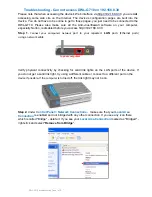
29-101
Cisco ME 3800X and 3600X Switch Software Configuration Guide
OL-23400-01
Chapter 29 Configuring IP Unicast Routing
Configuring Protocol-Independent Features
Setting Passive Interfaces
To prevent other routers on a local network from dynamically learning about routes, you can use the
passive-interface router configuration command to keep routing update messages from being sent
through a router interface. When you use this command in the OSPF protocol, the interface address you
specify as passive appears as a stub network in the OSPF domain. OSPF routing information is neither
sent nor received through the specified router interface.
In networks with many interfaces, to avoid having to manually set them as passive, you can set all
interfaces to be passive by default by using the passive-interface default router configuration command
and manually setting interfaces where adjacencies are desired.
Beginning in privileged EXEC mode, follow these steps to configure passive interfaces:
Use a network monitoring privileged EXEC command such as show ip ospf interface to verify the
interfaces that you enabled as passive, or use the show ip interface privileged EXEC command to verify
the interfaces that you enabled as active.
To re-enable the sending of routing updates, use the no passive-interface interface-id router
configuration command. The default keyword sets all interfaces as passive by default. You can then
configure individual interfaces where you want adjacencies by using the no passive-interface router
configuration command. The default keyword is useful in Internet service provider and large enterprise
networks where many of the distribution routers have more than 200 interfaces.
Controlling Advertising and Processing in Routing Updates
You can use the distribute-list router configuration command with access control lists to suppress routes
from being advertised in routing updates and to prevent other routers from learning one or more routes.
When used in OSPF, this feature applies to only external routes, and you cannot specify an interface
name.
You can also use a distribute-list router configuration command to avoid processing certain routes listed
in incoming updates. (This feature does not apply to OSPF.)
Beginning in privileged EXEC mode, follow these steps to control the advertising or processing of
routing updates:
Command
Purpose
Step 1
configure terminal
Enter global configuration mode.
Step 2
router {bgp | rip | ospf | eigrp}
Enter router configuration mode.
Step 3
passive-interface interface-id
Suppress sending routing updates through the specified Layer 3
interface.
Step 4
passive-interface default
(Optional) Set all interfaces as passive by default.
Step 5
no passive-interface interface type
(Optional) Activate only those interfaces that need to have
adjacencies sent.
Step 6
network network-address
(Optional) Specify the list of networks for the routing process. The
network-address is an IP address.
Step 7
end
Return to privileged EXEC mode.
Step 8
copy running-config startup-config
(Optional) Save your entries in the configuration file.
















































